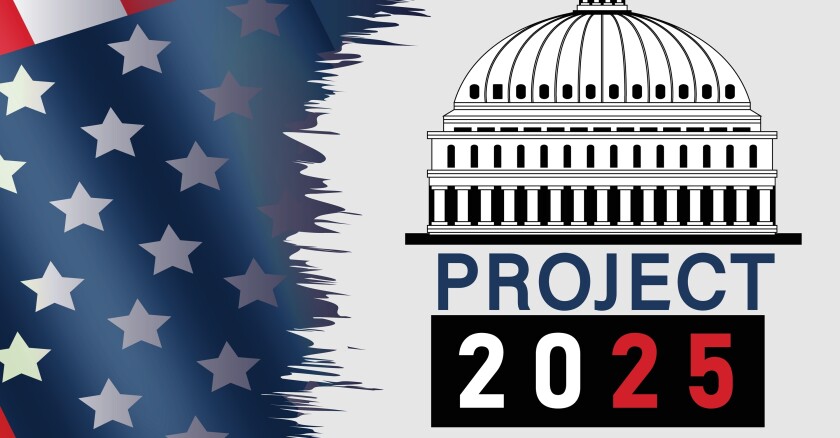In any case, CBS News summarizes Project 2025 as “a proposed presidential transition project composed of four pillars: a policy guide for the next presidential administration; a LinkedIn-style database of personnel who could serve in the next administration; training for that pool of candidates dubbed the ‘Presidential Administration Academy;’ and a playbook of actions to be taken within the first 180 days in office.” The Heritage Foundation’s wide-ranging 922-page document includes specific ideas which, if implemented, could have an enormous impact on higher education and K-12. You can learn more about Project 2025 yourself by going to the official website.
Project 2025 would reshape our government in a variety of ways. Rather than a generalized list of ideals, the plan provides specific individual steps to make unparalleled sudden changes to the shape of government. Forbes reports the plan “broadly proposes to insert far more political appointees who are ideologically aligned with the president into the executive branch — replacing many of the nonpartisan career civil servants who serve in it now.” Given the magnitude of these changes, let’s take a closer look at the plan to better understand its ramifications now and in the future.
ABOLISHING THE DEPARTMENT OF EDUCATION
The idea of dismantling the U.S. Department of Education has been talked about for decades but has recently become more mainstream, and could have a seismic effect on education throughout the U.S. if enacted. Established by Congress as a cabinet agency in 1979, the department’s mission was “to serve America’s students — to promote student achievement and preparation for global competitiveness by fostering educational excellence and ensuring equal access,” according to its website. The agency oversees federal education assistance to the states, collects data, enforces the prohibition of discrimination in education, establishes financial policies, and identifies educational issues.
More recently, the Department of Education was in the spotlight when it received over $30 billion through the CARES Act in response to the pandemic, to cover technological expenses associated with capacity and access to remote learning including hardware, software and instructional expertise. Subsequent stimulus bills brought that figure close to $190.5 billion. The agency also provides a variety of funding projects and programs through its Office of Educational Technology. For higher education, OET aims to help reimagine the role of technology, improve educational quality through innovative partnerships, support research in AI issues and expand broadband access.
Project 2025 recommends privatizing education and removing programs related to LGBTQ+ programming and diversity initiatives. The Guardian reported at a “faith and freedom conference” in June 2024 that some of the publicly articulated plans include:
- Cutting federal funding for schools that are “pushing critical race theory or gender ideology on our children,” and opening civil rights investigations into them for race-based discrimination.
- Barring trans youth from sports leagues that correlate with their self-identification rather than their assigned sex.
- Creating a body that certifies teachers who “embrace patriotic values.”
- Rewarding districts that do away with teacher tenure.
- Adopting a parents’ bill of rights.
- Having parents directly elect school principals, instead of electing school boards who then hire and supervise principals.
IMPACT ON STUDENT LOANS
As a recent story by Inside Higher Ed explained, if Project 2025 becomes a reality, it would “phase out income-driven repayment programs, put colleges on the hook for unpaid student loans and eliminate PLUS loans for graduate students and parents of undergrads," as well as eliminate the Office of Federal Student Aid.
This could have a big impact on the ability of current students to pay their debts and may dissuade future students from considering obtaining a college degree. In turn, in an environment of declining enrollments and lower external fundraising, some colleges and universities could be strained to cover their increasing operating costs and salaries. Educational institutions would find it more difficult to fund existing and replacement technology, and to invest in newer innovative and productive technologies. Colleges and universities already on the verge of closing might have to close their doors permanently.
K-12
In abolishing the Department of Education, Project 2025 aims to eliminate Title I (Every Student Succeeds Act) funding which provides grants to schools with large populations of low-income students. The purpose of this funding is to reduce achievement gaps between higher-income and lower-income districts and ensure children have, in the language of the bill, “a fair, equal, and significant opportunity to obtain a high-quality education.” In addition, technology funding for broadband connectivity and educational technology would be affected.
Project 2025 also proposes “a federal parents’ bill of rights,” which could potentially give parents stronger standing in court when the federal government “enforces any policy against parents in a way that undermines their right and responsibility to raise, educate, and care for their children,” as per the language in the proposal.
SCIENTIFIC RESEARCH
Project 2025 would extend cuts into broad areas which could likely affect science and research, particularly in higher education. The plan recommends deep cuts or elimination of federal monies for research and investment in renewable energy and calls to “stop the war on oil and natural gas.” Project 2025 has plans to downsize the National Oceanic and Atmospheric Administration (NOAA), which includes the offices of the National Weather Service and National Marine Fisheries Service. It suggests the agency “should be dismantled and many of its functions eliminated, sent to other agencies, privatized, or placed under the control of states and territories.” The plan’s rationale is to reduce “NOAA’s climate alarmism.”
Abolishing these scientific agencies and research could impact academic programs in higher education as well as student enrollments, research, technology funding, and a wide variety of STEM-related disciplines. It could also affect the U.S. weather warning network provided to the general public in case of deadly storms, especially exacerbated by a looming climate crisis.
CAN PROJECT 2025 HAPPEN?
Potentially yes, Project 2025 could happen. If a political party gains a majority in both the House of Representatives and the Senate, as well as the presidency, Project 2025 can become a reality. Presidential executive orders could also be used to implement many aspects of the plan. Whether Project 2025 becomes a reality will depend somewhat upon whether the electorate clearly understands its implications and agrees with its premise and outcomes. It might not only transform higher education, but the entire U.S. government. The result could be an earthquake of seismic proportions, especially for education and beyond.
Editor's Note: An earlier version of this story said CARES Act funding brought $30 billion to schools. It has been updated to reflect a much larger total, $190.5 billion, from subsequent stimulus bills.










